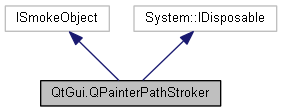|
Qyoto
4.0.5
Qyoto is a C# language binding for Qt
|
|
Qyoto
4.0.5
Qyoto is a C# language binding for Qt
|
The QPainterPathStroker class is used to generate fillable outlines for a given painter path. More...


Public Member Functions | |
| QPainterPathStroker () | |
| | |
| virtual void | CreateProxy () |
| new QPainterPath | CreateStroke (QPainterPath path) |
| | |
| new void | SetDashPattern (Qt.PenStyle arg1) |
| | |
| new void | Dispose () |
Protected Member Functions | |
| QPainterPathStroker (System.Type dummy) | |
Protected Attributes | |
| SmokeInvocation | interceptor |
Properties | |
| new Qt.PenCapStyle | CapStyle [get, set] |
| | |
| new double | CurveThreshold [get, set] |
| | |
| new double | DashOffset [get, set] |
| | |
| new System.Collections.Generic.List < System.Double > | DashPattern [get, set] |
| | |
| new Qt.PenJoinStyle | JoinStyle [get, set] |
| | |
| new double | MiterLimit [get, set] |
| | |
| new double | Width [get, set] |
| | |
| virtual System.IntPtr | SmokeObject [get, set] |
The QPainterPathStroker class is used to generate fillable outlines for a given painter path.
By calling the createStroke() function, passing a given QPainterPath as argument, a new painter path representing the outline of the given path is created. The newly created painter path can then be filled to draw the original painter path's outline.
You can control the various design aspects (width, cap styles, join styles and dash pattern) of the outlining using the following functions:
setWidth()
setCapStyle()
setJoinStyle()
setDashPattern()
The setDashPattern() function accepts both a Qt::PenStyle object and a vector representation of the pattern as argument.
In addition you can specify a curve's threshold, controlling the granularity with which a curve is drawn, using the setCurveThreshold() function. The default threshold is a well adjusted value (0.25), and normally you should not need to modify it. However, you can make the curve's appearance smoother by decreasing its value.
You can also control the miter limit for the generated outline using the setMiterLimit() function. The miter limit describes how far from each join the miter join can extend. The limit is specified in the units of width so the pixelwise miter limit will be miterlimit * width. This value is only used if the join style is Qt::MiterJoin.
The painter path generated by the createStroke() function should only be used for outlining the given painter path. Otherwise it may cause unexpected behavior. Generated outlines also require the Qt::WindingFill rule which is set by default.
|
protected |
| QtGui.QPainterPathStroker.QPainterPathStroker | ( | ) |
Creates a new stroker.
|
virtual |
| new QPainterPath QtGui.QPainterPathStroker.CreateStroke | ( | QPainterPath | path | ) |
Generates a new path that is a fillable area representing the outline of the given path.
The various design aspects of the outline are based on the stroker's properties: width(), capStyle(), joinStyle(), dashPattern(), curveThreshold() and miterLimit().
The generated path should only be used for outlining the given painter path. Otherwise it may cause unexpected behavior. Generated outlines also require the Qt::WindingFill rule which is set by default.
| new void QtGui.QPainterPathStroker.Dispose | ( | ) |
| new void QtGui.QPainterPathStroker.SetDashPattern | ( | Qt.PenStyle | arg1 | ) |
Sets the dash pattern for the generated outlines to style.
See also dashPattern().
|
protected |
|
getset |
Returns the cap style of the generated outlines.
Sets the cap style of the generated outlines to style. If a dash pattern is set, each segment of the pattern is subject to the cap style.
|
getset |
Returns the curve flattening threshold for the generated outlines.
Specifies the curve flattening threshold, controlling the granularity with which the generated outlines' curve is drawn.
The default threshold is a well adjusted value (0.25), and normally you should not need to modify it. However, you can make the curve's appearance smoother by decreasing its value.
|
getset |
Returns the dash offset for the generated outlines.
Sets the dash offset for the generated outlines to offset.
See the documentation for QPen::setDashOffset() for a description of the dash offset.
|
getset |
Returns the dash pattern for the generated outlines.
Sets the dash pattern for the generated outlines to style.
|
getset |
Returns the join style of the generated outlines.
Sets the join style of the generated outlines to style.
|
getset |
Returns the miter limit for the generated outlines.
Sets the miter limit of the generated outlines to limit.
The miter limit describes how far from each join the miter join can extend. The limit is specified in units of the currently set width. So the pixelwise miter limit will be miterlimit * width.
This value is only used if the join style is Qt::MiterJoin.
|
getset |
|
getset |
Returns the width of the generated outlines.
Sets the width of the generated outline painter path to width.
The generated outlines will extend approximately 50% of width to each side of the given input path's original outline.